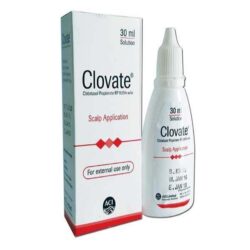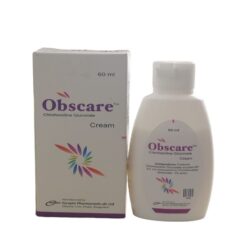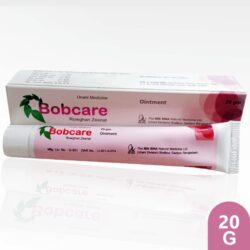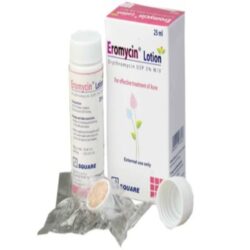Clindacin Lotion
৳ 125.00
Clindacin Lotion
Description
Medicine Overview of Clindacin Lotion 10mg/ml Lotion
Introduction
Clindacin Lotion is an antibiotic that fights bacteria. It is used to treat acne, which appears as spots or pimples on your face, chest or back. This medicine works by attacking the bacteria that cause these pimples. Clindacin Lotion is only meant for external use and should be used as advised by your doctor. You should normally wash and dry the affected area before applying a thin layer of the medicine. It should not be applied to broken or damaged skin. Avoid any contact with your eyes, nose or mouth. Rinse it off with water if you accidentally get it in these areas. It may take several weeks for your symptoms to improve, but you should keep using this medicine regularly. Do not stop using it as soon as your acne starts to get better. Ask your doctor when you should stop treatment. Common side effects like minor itching, burning, or redness of the skin and oily skin may be seen in some people. These are usually temporary and resolve on their own. Consult your doctor if they bother you or do not go away. It is a safe medicine, but you should inform your doctor if you have any problems with your bowels (intestines). Also, inform the doctor if you have ever had bloody diarrhea caused by taking antibiotics or if you are using any other medicines to treat skin conditions. Consult your doctor about using this medicine if you are pregnant or breastfeeding.
Uses of Clindacin Lotion
Side effects of Clindacin Lotion
Common
Skin rash
How to use Clindacin Lotion
Use this medicine in the dose and duration as advised by your doctor. Check the label for directions before use.
How Clindacin Lotion works
Clindacin Lotion is an antibiotic. It works by preventing synthesis of essential proteins required by bacteria to carry out vital functions. Thus, it stops the bacteria from growing, and prevents the infection from spreading.
What if you forget to take Clindacin Lotion?
If you miss a dose of Clindacin Lotion, take it as soon as possible. However, if it is almost time for your next dose, skip the missed dose and go back to your regular schedule. Do not double the dose.
Quick Tips
You have been prescribed Clindacin Lotion for the treatment of acne.
You may have to use it for a long time before your acne starts to improve. Be patient and keep using it every day.
Wash your skin with a mild cleanser and pat it dry before applying Clindacin Lotion.
Apply it as a thin layer onto clean, dry, unbroken skin affected by acne.
It may cause minor burning, stinging or irritation when applied. Inform your doctor if this does not go away.
Avoid contact with your eyes, nose or mouth. Rinse it off with water if you accidentally get the cream in these areas.
If you think the area of skin you are treating has become more irritated and infected, you should stop using Clindacin Lotion and consult your doctor.
Brief Description
Indication
Acne vulgaris, erythrasma, rosacea, periorificial dermatitis, folliculitis, stasis, chronic lymphaedema and familial pemphigus, dermal ulcers.
Adult Dose
Topical/Cutaneous Acne Adult: As 1% preparation: Apply a thin layer onto affected area bid.
Child Dose
<12 years old Safety and efficacy not established >12 years: Apply a thin layer onto affected area bid.
Contraindication
Contraindicated in patients with hypersensitivity to clindamycin.
Mode of Action
Clindamycin inhibits protein synthesis by reversibly binding to the 50S subunit of the ribosomal thus blocking the transpeptidation or translocation reactions of susceptible organisms resulting to stunted cell growth.
Precaution
It is not for oral, ophthalmic, or Intravaginal use. Avoid exposure to sunlight and sunlamps. Wear sunscreen daily. Lactation: Excretion in milk unknown; use with caution
Side Effect
>10% Dryness (18-23%),Oiliness (1-18%),Erythema (7-16%),Peeling (7-11%),Burning/itching (6-11%) 1-10% Headache (3%)
Pregnancy Category Note
Pregnancy In clinical trials with pregnant women, systemic administration of clindamycin during second and third trimesters has not been associated with increased frequency of congenital abnormalities; there are no adequate studies in pregnant women during first trimester of pregnancy; clindamycin should be used during first trimester of pregnancy only if clearly needed Lactation Not known whether clindamycin is excreted in human milk following therapy; however, orally and parenterally administered clindamycin has been reported to appear in breast milk; clindamycin has potential to cause adverse effects on breastfed infant’s gastrointestinal flora; if oral or intravenous clindamycin is required by a nursing mother, it is not a reason to discontinue breastfeeding, but an alternate drug may be preferred; monitor infant for possible adverse effects on gastrointestinal flora, such as diarrhea, candidiasis (thrush, diaper rash) or rarely, blood in the stool indicating possible antibiotic-associated colitis Developmental and health benefits of breastfeeding should be considered along with mother’s clinical need for clindamycin and any potential adverse effects on breastfed child from clindamycin or from underlying maternal condition
Interaction
May enhance the action of neuromuscular blocking agents (e.g. atracurium). May antagonise the effects of parasympathomimetics. May competitively inhibit the effects of macrolides, ketolides, streptogramins, linezolid and chloramphenicol. Increased coagulation tests (prothrombin time/INR) and/or bleeding w/ vit K antagonists (e.g. warfarin, acenocoumarol, fluindione).
Brand
Incepta











Reviews
There are no reviews yet.